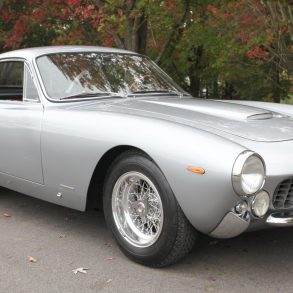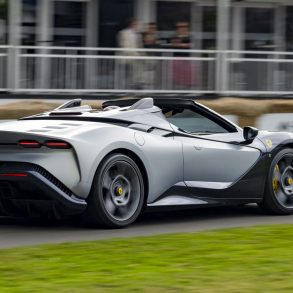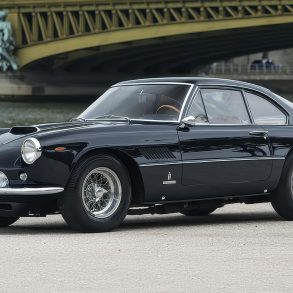
This 1960 Ferrari 250 GT SWB Alloy Competizione did not sell at the high bid of $4,400,000 during the Gooding & Company “Scottsdale Auction” held January 17th in Scottsdale, Arizona.
In the summer months of 1959, after completing the last 13 examples of the venerable 250 Tour de France models, Ferrari constructed the forefather of the Short-Wheelbase Berlinetta (SWB). Seven “interim” cars based on the long-wheelbase chassis were built to test the design that would soon be applied to the forthcoming short-wheelbase chassis. Their first competition appearance was at the 1959 running of the 24 Hours of Le Mans and it proved promising for Ferrari’s newest Gran Turismo.
Following the introduction of the “interim” prototypes, the design of the car had been further refined and the first official Ferrari 250 GT SWB appeared on Ferrari’s stand at the Paris Salon. With revisions to its smoothly tapered curves and an imposing egg crate grille filled with Marchal lamps, the SWB possessed a much more aggressive and purposeful appearance than its predecessor. Underneath, the chassis was improved as well. The suspension boasted stiffer springs, adjustable shock absorbers and antiroll bars, and very importantly, the new car was equipped with 4-wheel disc brakes, a first for a Ferrari Berlinetta. The short wheelbase and light weight imbued the car with brilliant handling characteristics and nearly perfect manners, whether drifting through corners on a track or driving quickly through a narrow road course. Competizione cars received larger brake calipers, outside fuel fillers, upgraded suspension and lightweight aluminum bodywork. Above all, the Competizione SWB models were equipped with the type 168 B motor. Built strictly for racing, this engine featured a horizontally mounted oil filter, Testa Rossa heads, coil-type valve springs, velocity stacks and individual ports and was capable of producing upwards of 270 bhp.

The new Ferrari 250 GT SWB was not homologated during its earliest races thereby forcing it to compete directly with purpose-built sports racing cars where it was an instant success. Had it been homologated sooner, the three cars entered for the 1960 Sebring would have easily swept the GT category. At the Targa Florio, a still yet-to-be-homologated SWB finished 9th overall in front of the GT class winner – a 1959 Tour de France (TdF). At the Grand Prix of Rouen in the summer of 1960, the new Ferraris finished in 3rd and 4th place and it was clear to all who witnessed its earliest outings that the SWB was the car to beat heading into Le Mans. Without much competition, a pack of SWBs finished Le Mans in 4th to 7th place overall and swept 1st through 4th place of the GT class embarrassing even the most sophisticated sports racing cars.
After that impressive performance the Short-Wheelbase went on to win the 25th Tourist Trophy at Goodwood and a week later proved victorious at Brands Hatch. The racing successes would continue for the next few years with an incredible string of successes at Nassau, Silverstone, the Daytona Continental, the Coppa Inter-Europe, Spa-Francorchamps, the Tour de France, Montlhery and the Nurburgring. After taking European races by storm, the SWB began racing extensively in the US, where it dominated SCCA competition for several years.
The SWB is one of the most successful Ferrari GTs ever constructed. It is a car that competed with unrivaled success in rallies, races and hill climbs. Today, they are still a force to be reckoned with whether competing in competitive vintage racing, driving events or concours d’elegance. While its predecessor, the TdF, is a touch too temperamental and cramped to be used on the road, and its successor, the mythical GTO, is either unobtainable or too raucous to be lived with on the street, a Short-Wheelbase is at home on road or track, and its gorgeous, timeless design ensures that it appeals to nearly every enthusiast – to many, the 250 GT SWB remains the epitome of the Ferrari Gran Turismo.
Chassis Number 1759 GT
From the outset, 1759 GT was built to win races at the highest levels of competition. As is noted on the build sheets, this car was built specifically to compete at the 1960 24 Hours of Le Mans. On January 18, 1960, the bare chassis frame was sent to Carrozzeria Scaglietti to be fitted with a lightweight alloy body. While this work was being carried out, the major mechanical components were being completed at the Ferrari factory and tested. Built for the explicit purpose of racing at Le Mans, 1759 GT incorporated every competition component available at the time, from the alloy gearbox casing to the 128 LM heads used on the 250 Testa Rossa.

When the Tipo 539 chassis was completed on March 17 it was only the 6th of 165 Short-Wheelbase Berlinetta cars ever built – around 40 of these were factory built as competizione cars like 1759 GT. Little more than a month had passed before the completed car was taken to the challenging Monza Autodrome where it was factory tested in preparation for Le Mans. At Monza, Ferrari’s great factory drivers – Richie Ginther, Phil Hill and Wolfgang von Trips – put the initial test mileage on the car and assured that 1759 GT was well sorted for its competition debut.
Soon after, on June 18, with financing from Dr. Harvey Schur of Scarsdale, New York, Luigi Chinetti Motors of New York purchased the car from Ferrari. Its destiny was to compete at Le Mans as Luigi Chinetti’s entry for the fabled North American Racing Team (N.A.R.T.)
The 28th Annual 24 Hours of Le Mans was held on June 25, 1960, and 1759 GT appeared on track, ready to do battle against one of the most impressive grids Le Mans had yet to see. When seen on track, the car was finished as when it left the factory, in red with a black interior, however, by the time it had arrived in France 1759 GT wore a distinctive white and blue noseband with a N.A.R.T. insignia and was fitted with rear brake cooling scoops placed in front of the rear wheels, a bug deflector and narrow TdF-style Borrani wire wheels.
Ed Hugus and Augie Pabst, who had just come from an impressive 4th overall performance at Sebring, were the pilots. Wearing number 19, the car fought through the day and night against stiff competition that included Testa Rossas, DBR1s, RSKs and three other factory-prepared SWBs. At the end of the 24 hours, 1759 GT crossed the finish line, finishing 7th overall and 4th in the Gran Turismo class. The car had finished the legendary race at an impressive average of 104 mph and only 14 laps behind the winning 250 TR 59 of Gendebien and Frère.

In late 1961, after its glorious outing in France, Dr. Schur returned his SWB to Chinetti Motors at which time the instruments were changed from kilometers to miles. In early 1962, the car was sold to Gil Horton, an avid racing enthusiast living in Jamestown, North Dakota, and as early as June 30, 1759 GT was entered in the 4th Annual Black Otter Hillclimb in Billings, organized by the Montana Sports Car Club. Mr. Horton continued to use the car enthusiastically and it subsequently made appearances at a number of American racing events. Later in 1962, it was seen in the paddock at the 500-mile race at Road America in Elkhart Lake, Wisconsin.
By 1967, Horton had sold the car to California resident Mark Slotkin, who in turn sold the car to knowledgeable Ferrari enthusiast, Charles Betz and his business partner Fred Peters. Betz held on to the Ferrari until 1974 when it was sold to another Southern California-based Ferrari enthusiast Phillip Bronner of Rancho Palos Verdes. At the time 1759 GT was registered on the black California license plate ZZX 073. In August 1975, Bronner raced his prized SWB at the second running of the Monterey Historics at Laguna Seca where it performed very well in its heat. After taking a year off, Bronner entered his car into the 4th Annual Historics and continued to race the car at the Historics for the next few years. After the races in 1980, Mr. Bronner sold 1759 GT to another enthusiast and vintage racer, Peter Giddings.
Mr. Giddings continued to use the car before selling it to Tom Mudd in 1983. Mr. Mudd took care of the car for almost 20 years during which time he commissioned Kent White to begin restoration work. The work was not completed and, in 2002, he sold 1759 GT to Martin Eyears. By October of that year, the car was sent to Tony Merrick’s famed GTO Engineering where an exhaustive and extremely accurate restoration was commenced. During the process, it was apparent that the car had remained in largely original condition, with all its bodywork, original engine and mechanical components still intact, even after almost four decades of racing.
By 2005, 1759 GT was in the hands of Peter Le Saffre, who returned the car to vintage racing, competing in the XV Palm Beach Cavallino Classic in Florida in January 2006. That summer the car was sold to its current owner who has since shown the car at the XVI Cavallino Classic at the Breakers Hotel and has run at Road Atlanta. During this time the car has been carefully maintained and serviced by Wayne Obrey’s Motion Products and David Moore’s Moorespeed, two of the best names in vintage Ferrari race preparation. Moorespeed has maintained the car for the past several years and has tended to the purpose-built racing engine, which has been built to be competitive at the highest levels of vintage racing. In its build, Carillo Rods, CP pistons and titanium valves have been used, providing amounts of power and reliability that were unheard of in the 1960s. In its preparation, a roll cage, fire safety system and Willans racing harness have been installed to comply with the current vintage-racing standards.

1759 GT is one of the earliest Short-Wheelbase Berlinettas ever built. Moreover, it was one of the first SWBs campaigned by Ferrari in its bid for the 1960 Manufacturers Championship. This car is currently presented in its 1960 Le Mans livery and is equipped with the handsome, early version of the crackle-finish dashboard, unique competizione features and includes its original engine, TdF-style wheels and the Snap exhaust system that the car raced with at Le Mans in 1960. 1759 GT boasts an unparalleled preparation, extremely authentic restoration and a history that is beyond reproach, with an impressive record at the world’s most important racing events. The Short-Wheelbase Berlinetta is a racing legend, a landmark design and a virtually guaranteed entry into any prestigious international event where it will be a staunch competitor on or off the track. The SWB remains one of Ferrari’s finest, and is the last great dual-purpose sports car ever constructed in the Golden Era of GT racing.
[Source: Photos by Pawel Litwinski © 2008, Courtesy of Gooding & Company]










woohh…I like that!the engines looks good…
OK, very far from being an authority here – but I alluz heard that the GTO was the “last great dual-purpose . . .” I mean Henry Manney III used to drive his GTO on the street (before he sold it for c. $10K!!!)
Maybe the SWB was the first “last great dual-purpose…”
Horizontal oil filter/vertical oil filter? The one pictured in the engine bay looks vertical to me… T.
Now that is a good catch…
Lets face it 1960-1961 SWB 250GT very special, very special indeed. The lines and the simple design look great 47 years later. And what an investment, there are very few race cars that pay for them selves and all their upkeep and racing bill’s for 47 years. The 250GT for the record would have been one of them.